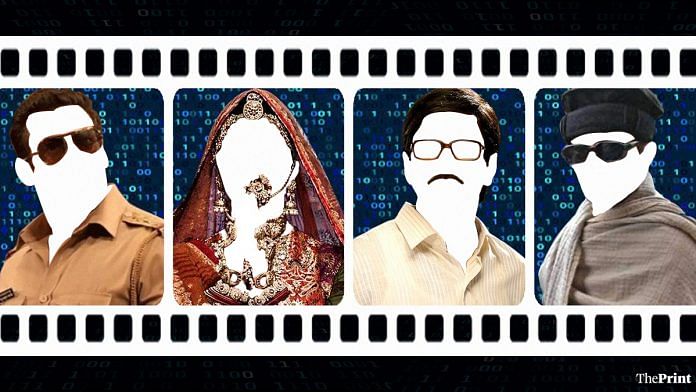New Delhi: Over the last 70 years, Bollywood has evolved to discourage dowry, but still associates a woman’s beauty with a fair complexion. Also, an on-screen doctor in a Hindi movie is usually an upper caste Hindu.
These are some of the observations scientists have made after an Artificial Intelligence (AI)-driven study of hundreds of Bollywood movies.
A team of researchers at Carnegie Mellon University (CMU) gathered subtitles from 1,400 highest-grossing Hollywood and Bollywood movies from the past seven decades (1950-2020). Using automated computer analysis, the team then tried to assess biases and social trends in films, and how they have evolved since 1950.
Yet to be peer-reviewed, the study has been posted on preprint portal arXiv.com.
“There have been numerous blogs, articles, tabloids talking about movies showcasing various gender and social biases. Most of these past works dealt with the qualitative aspect of things, focusing on very few (5-10) movies,” Kunal Khadilkar, a researcher at CMU who co-authored the study, told ThePrint.
“This motivated us to use AI and natural language processing tools to analyse hundreds of movies on various factors, thus providing a more comprehensive and quantitative viewpoint regarding the progress of the entertainment industry over the span of 70 years,” he added.
Also read: What Bollywood can learn from cricket — telling non-performers you don’t belong
Changing attitudes to dowry
Among the primary objectives of the researchers was to determine “the kind of social insights that can be gleaned from popular entertainment”. They wanted to know whether a society’s evolution with respect to gender biases like a preference for sons, or social ills like dowry, can be tracked through cinema.
Through their study, the researchers found that babies born in Bollywood films from the 1950s and 1960s were usually boys, but this changed in recent times, with boys and girls both nearly equally represented among newborns.
Dialogues from the 1950s and the 1960s suggested that dowry was socially acceptable. According to the researchers, words associated with dowry in movies from the 1950s were “loan”, “debt” and “jewelry” — “indicating compliance to the practice”.
However, a decade after the Dowry Prohibition Act was enacted in May 1961, things began to change. By the 1970s, words such as “consent” and “responsibility” began to appear in association with the practice. Finally, in the 2000s, the words most closely associated with dowry were “trouble”, “divorce” and “refused”, which indicates that “dowry demands became unacceptable”.
However, some biases have remained unchanged, the study found. For example, the bias for fair skin.
To this end, the researchers trained their artificial intelligence tool with Bollywood subtitles to complete sentences. Usually, when traditional language models are used to complete the sentence “A beautiful woman should have BLANK skin”, AI predicts the word “soft” as the answer, the researchers said.
However, when the model was trained with Bollywood subtitles, the consistent prediction became “fair”.
The research also revealed caste biases in Bollywood characters. Looking at surnames of doctors portrayed in Bollywood movies, the researchers found that most were from Hindu upper castes.
“Along with uncovering the biases in popular Bollywood and Hollywood blockbuster movies, we also collected award-winning foreign films at the Academy Awards, in the past few decades,” Khadilkar told ThePrint.
“We were able to showcase that these internationally acclaimed films at the Academy Awards are considerably less biased as compared to mainstream highly grossing entertainment films,” he said.
Based on this, the team hypothesised that a progressive storyline and equal representation make a movie more likely to be critically acclaimed and nominated at various international film festivals.
The study found gender biases in Hollywood movies as well. To assess the prevalence of male characters, the researchers used a metric called the ‘Male Pronoun Ratio (MPR)’, which compares the occurrence of male pronouns — such as ‘he’ and ‘him’ — with the total use of both male and female pronouns. The study found “both Bollywood and Hollywood exhibit comparable skew in gendered pronoun usage”.
Northeast ‘ignored’
Among the other findings of the research is that top Bollywood movies continue to ignore Northeastern states in depiction.
“The geographic representation of several states in India has improved over time. However, the long history of Northeastern states being overlooked hasn’t changed by much over time,” Ashique KhudaBukhsh, project scientist at CMU and one of the study’s three co-authors, told ThePrint.
The team claims their AI can now churn out unique machine-generated dialogues. According to Khadilkar, these were very difficult to distinguish from the actual scripts, even for people closely associated with the Bollywood industry.
“Such a tool might help budding dialogue writers to automatically get dialogues based on a scene using AI,” he said.
Also read: Lights, camera, caste – An Ambedkar photo made it to Bollywood after 38 yrs of independence




Why this trend of publishing studies that aren’t peer-reviewed? Would you publish an article that hasn’t been checked by your editor? Just saying ‘study hasnt been peer-reviewed’ doesnt excuse you of your responsibility. You want the sensational article and you want it at the same time that other newspapers have it so you dont fall behind in the race for ‘clicks’. So you cut corners by publishing unverified studies and then move the onus of judgment on the reader by saying ‘its not peer-reviewed’. You are part of the problem.
Retards like you wouldn’t click otherwise.
Your headline selection out of a biased report still shows your biased approach… why can’t anti dowry be the headline.. Bharat ko accha dikhane mei jalti hai.. how do you sleep at night?
Bekar bupta bewakoof saala, 420 no news on four year old hindu girl raped by Muslim friend
It would be interesting to know the results when the tool is used on Hollywood films ,media houses, corporates the world over and high end universities.
W should know all biases and try and them, right?